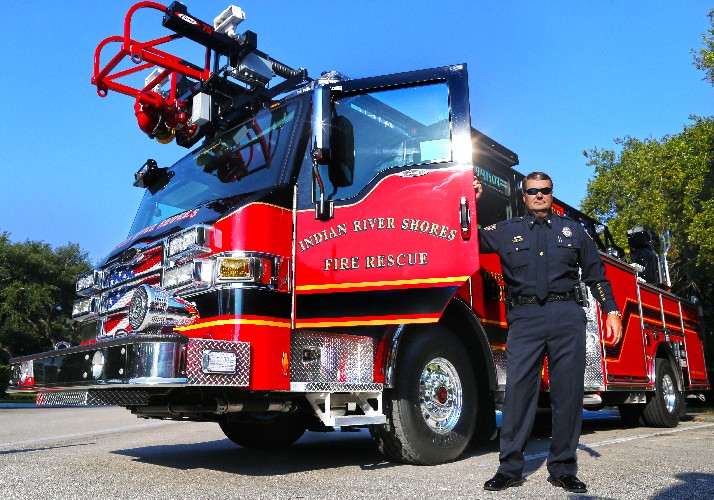
INDIAN RIVER SHORES — While still enjoying the new-car smell of its brand-spanking new firetrucks, the Indian River Shores Town Council last week was trying to decide what to do with one of the retired vehicles, which sparked some unexpected debate.
One of the vehicles was traded in, saving taxpayers nearly $31,000 on the newer model, but the 1989 ladder truck doesn’t fetch so much at the dealer. One big reason is that its open cab seating is out of safety compliance – the town had rigged a work-around until the new truck arrived. Another reason for its diminished resale value is that its ladder is only 50 feet long, compared to the 75-foot reach of the newly arrived truck, which can spray 1,250 gallons per minute and has enough pressure to reach the entire 75-foot span of the ladder.
Town Manager Robbie Stabe said he could put the ladder truck up for sale on a government surplus website, but that if past comparable sales are any indication, it might take several months to off-load the vehicle and the going price is about $5,500. In the meantime, the Town would need to maintain the vehicle and perform a required pumper test on it come June. That test costs between $1,000 and $1,500 and the truck barely passed muster last year, so repairs might be needed after a failed test.
Stabe suggested the town donate the truck to the Indian River State College Treasure Coast Public Safety Training Complex in Fort Pierce. In addition to being good public relations for the Town, he said, it would be “a contribution to the training facility.”
That 50-acre facility, which combines criminal justice, fire science, forensics and emergency management programs, graduates roughly 90 percent of the firefighters hired by the town, and town public safety employees return there for continuing education and re-certification. The academy does not have its own ladder truck on which to train firefighters.
It appeared that the council would acquiesce when Councilman Dick Haverland spoke up. “If this is worth $5,000 to someone, for us to be giving away – well it’s not the Town’s money – is inappropriate,” Haverland said.
Haverland suggested Stabe try to sell it and if there were no takers, then re-consider giving the truck away.
Acting Public Safety Director Capt. Mike Jacobs said the town makes good use of the academy training facilities, especially for firearms requalification. He said some facilities and classes are provided gratis and some come with a fee. Some are funded by grants. “And the college has a fire tower, we want to be able to train at their tower,” Jacobs said, to help with the Town’s upcoming ISO fire protection rating audit.
Councilman Tom Slater suggested a compromise that wouldn’t necessarily involve the exchange of cash. “I wonder if we could get some sort of a credit?” he asked.
Mayor Brian Barefoot told Stabe and Jacobs, “See if you can work out some sort of a deal and bring it back to us in May. My preference would be to see it go to IRSC for the obvious benefits, but I think we need to take one more step.”
Last year the Town Council voted to spend a total of $1.3 million on new public safety “rolling stock,” including the two trucks, one police cruiser and four administrative vehicles, because they’d put off replacing that equipment for many years and the Town had funds in its account from its share of the one-cent optional sales tax. Property taxes were not used to purchase the new fire trucks. The fire trucks are expected to last between 10 and 15 years, or up to 20 depending upon corrosion from being so close to the ocean.



